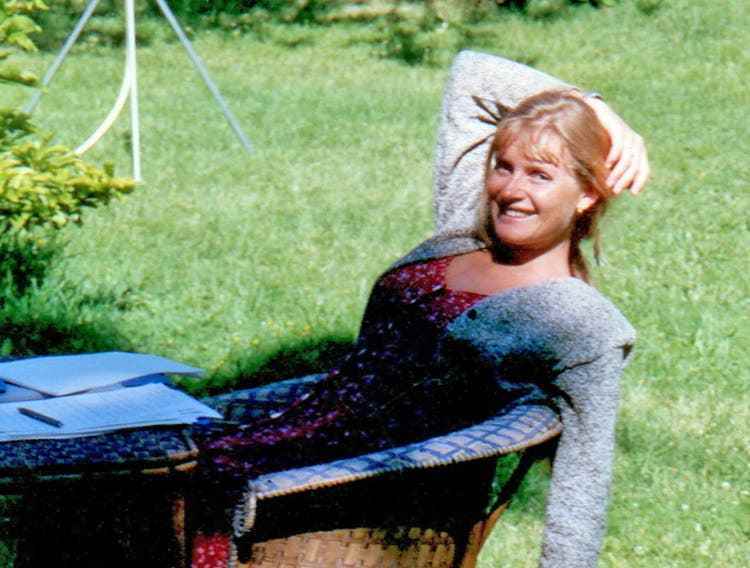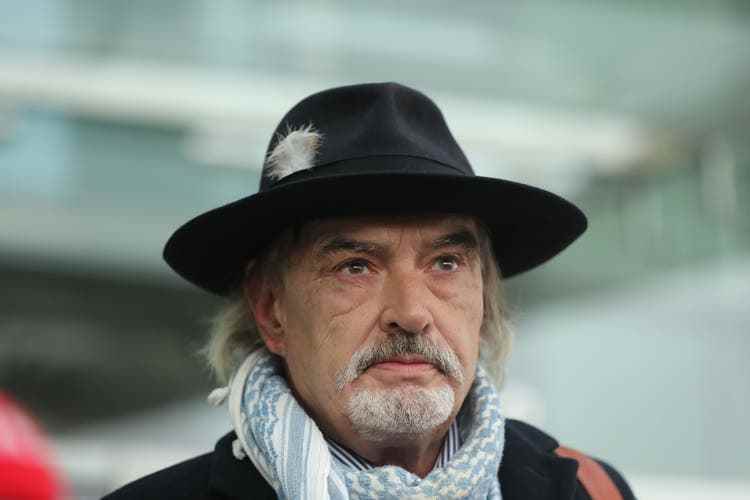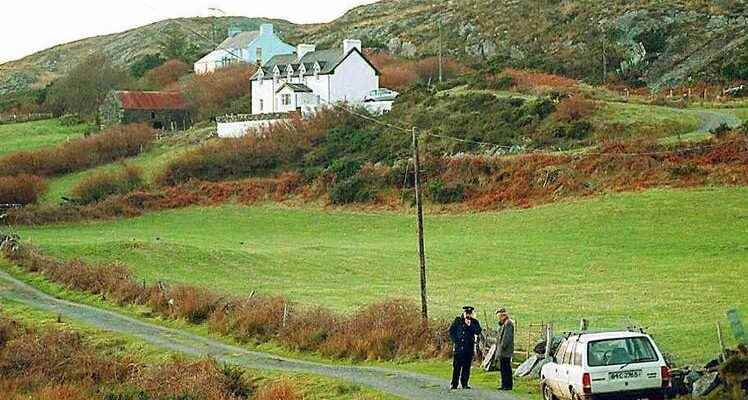A French woman murdered in Ireland in 1996. A suspect who is convicted and yet is at large. A witness who keeps changing her statements. No other case in Ireland has been more unsuccessfully investigated. But now there is a new lead.
On December 23, 1996, French film producer Sophie Toscan du Plantier was found murdered not far from her Irish holiday home. The case remains unsolved in Ireland to this day.
In 1993, Sophie Toscan du Plantier bought a holiday home near Schull, West Cork, Ireland, which she used regularly, including at Christmas 1996, as a quiet retreat from her busy life in Paris. She arrived alone just before the holidays and wanted to be back in Paris for Christmas.
But things turned out differently: on December 23, 1996, at 10 a.m., a neighbor found her dead in a driveway to a field below her holiday home.
Her skull had been smashed in with a blunt rock – her face was so disfigured that the neighbor could not officially identify her. Her blood was found on the iron gate of the driveway, as well as on a slab of slate and a concrete block.
There are six books, two movies and one podcast in the Sophie Toscan du Plantier murder case and no conviction – at least not in Ireland, where she was murdered in 1996.
But there was one suspect from the start: Ian Bailey, a Brit living in Ireland, quickly became a suspect. He was arrested twice in connection with the murder but was never charged. The evidence was repeatedly found to be insufficient and there was never a prosecution or trial in Ireland.
In Ireland, Bailey is presumed innocent. Not so in France, where he was found guilty in absentia of the murder of Sophie Toscan du Plantier in 2019. He himself denies the fact.
His extradition to France was requested three times, each time Ireland refused. The Irish High Court did not want to extradite anyone whose guilt it was unsure of.
Now the Irish judiciary wants to reopen the “cold case”. Prime Minister Micheál Martin recently said at a press conference: “Everything must be done to find out who committed this murder.”
All aspects of the original 1996-1998 investigation, from witness statements to forensics, are to be reviewed by specialized officers using modern technology.
The file has 4000 pages.
The first and only murder case
Sophie Toscan du Plantier was a French television producer, aged 39 at the time of her death and mother of one son.
Her marriage to the French film producer Daniel Toscan du Plantier was initially considered exemplary, but in the end it was more like a business agreement with great freedom for both parties.
Sophie Toscan du Plantier spent time with a lover at her vacation home. After the death of his wife, Daniel Toscan du Plantier soon had a child with a mistress whom he married as his fourth wife in 1998. And when it came to identifying his dead wife in Ireland, he didn’t come.

The victim Sophie Toscan du Plantier in Combret in southern France. At the time of her death she was 39 years old and the mother of one son.
In this remote area, so far south on the island that only the Atlantic beyond it, it was the first and only murder case.
Local police were overwhelmed by the task: the body was left outside for 28 hours until the Dublin pathologist arrived. The time of death could not be determined afterwards.
The Gardaí, as the Irish police are called, have been accused of misconduct in handling evidence and witnesses – including suspect Ian Bailey. The officials are said to have urged witnesses to make false statements and generally bungled.
The suspect writes about the case himself
Bailey is British and has lived in the area since 1992. At the time of the murder he was living with his partner and working as a freelance journalist.
He wrote himself about the case in which he was involved as a suspect.
In his articles he said that Sophie Toscan du Plantier had “several male companions” and directed the suspicion to France – a lead that was subsequently followed up.
At the same time, more and more people testified against him. A witness claimed to have seen Bailey on a bridge not far from the crime scene on the night of the crime. His home was four kilometers from the victim’s.
She later retracted the statement, saying police urged her to identify the man on the bridge as Bailey. In 2005, she publicly apologized to him in a television interview.
Bailey reportedly said to a boy that he “put a rock at her [Sophie Toscan du Plantier] approached” and “hit her brain”.
In addition, he is said to have said to acquaintances in 1996 after an alcohol-heavy evening: “I did it, I did it – I went too far.” Bailey claims to have never said either of these things to this day.
conviction for assault
Other inconsistencies also suggested that Bailey was the perpetrator: Apparently, he first heard about the murder when a reporter from the Irish Examiner told him about it at 1:40 p.m. on December 23. But the reporter did not know at the time that the victim was French. Still, several witnesses said Bailey had told them before noon that he was covering the murder of a French woman.
He also had scratches on his forearms and an injury on his forehead on December 23, which Bailey said were from cutting down a Christmas tree the day before. However, witnesses who were with him on the evening of December 22 could not recall any scratches.
Bailey and his partner were arrested twice in connection with the murder but were always released without charge. The statements the couple made to the police were apparently contradictory. Bailey claims to this day that he did not leave the house on the night of the crime.
In addition, the relationship between Bailey and his partner was marked by violence. In 2001 he was convicted of assault for being violent towards his partner – for the third straight time, he would later admit.
All of this quickly caused a polarization of public opinion that continues to this day: was he or wasn’t he?
A man who “always seeks the limelight”
For the murder investigation, Bailey had to undergo a psychiatric evaluation. The expert concluded that he had a personality tending towards “narcissism, violence, impulsiveness and egocentricity with a great need for approval” and that he was prone to violence when under alcohol.
Similarly said by the judge who ruled on the 2003 defamation lawsuit Bailey filed against eight newspapers and lost. The judge described him as a man who “always seeks the limelight”.
Perhaps because Bailey, like Oscar Wilde, felt that not being talked about was worse than being talked about, he appealed the verdict in the 2007 libel case and in 2014 sued the state for wrongful arrest and other misdemeanors.

Suspect Ian Bailey at the High Court in Dublin, Ireland, in 2020 after the court ruled not to grant France’s third extradition request either.
France is investigating on its own
The three processes brought a lot of media attention – for Bailey, but also for the case. In France, the story came back into the public eye: How could it be that a French woman was murdered ten years ago and it is still not known who did it?
In the same year, the French judiciary launched an investigation. Until 2017, French police repeatedly visited West Cork, where they interviewed witnesses and inspected the original files. She even had the victim’s body exhumed and subjected to a second autopsy.
In 2019 there was a court case. Ian Bailey was the accused. But for him it was a “farce”. He refrained from a defense and never went to Paris for the trial.
His protest did not help: the court found Bailey guilty of murder and sentenced him to 25 years in prison and a fine of 225,000 euros.
A year later, France issued a European arrest warrant for Bailey, which Ireland never complied with. Since then, Bailey has not left the country for fear of being extradited.

The files are ready at the Palais de Justice de Paris, where the trial of Ian Bailey took place in 2019. It’s around 4000 pages.
Was he right from the start?
And now, 26 years later, Ireland’s most famous unsolved murder case is set to face a “full investigation”. Because the two documentaries on sky and Netflix have produced new clues.
It all started with a statement from a local woman: The victim is said to have been followed by an unknown man the day before she died. Last year, the witness identified the pursuer as an employee of Daniel Toscan du Plantier, the victim’s husband.
What is explosive is that the witness is the woman who claimed for years to have seen Bailey on the bridge near the crime scene on the night of the crime, but later withdrew the statement.
Regardless of the credibility of the witness, the trail must now be followed, a retired police chief told the “Irish Independent”. The Gardaí plan to interview the identified person in France and secure his DNA.
In his articles, Bailey repeatedly raised the question of whether the trail led to France rather than to him. Was he right from the start?
A secret message for the killer
It is not that easy. Another witness now wants to recall seeing Bailey handling blood-stained clothing the day after the murder.
But the book “Murder at Roaringwater”, published in 2021 and written by Nick Foster, also provided new evidence. And this made Bailey suspect as the perpetrator.
Foster spoke to numerous witnesses as part of his research, two of whom shared previously unknown information with him.
Foster himself is convinced of Bailey’s guilt. An entry in the victim’s diary confirms that Bailey knew the victim – although he himself has always denied this.
In addition, the French filmmaker Guy Girard testified in 1999 that Sophie Toscan du Plantier had told him about her “boyfriend” Ian Bailey shortly before her death.
Foster continued to comment on the case and told the “Irish Mirror” even that he put a secret message in his book telling the alleged killer that he knew the truth. It remains to be seen whether Foster really knows who it was, or whether he only wants to use it to promote his book.
The book, at least, is a bestseller.
